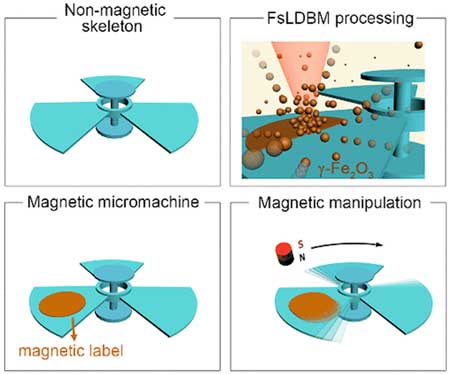| Feb 11, 2021 | |
Extending magnetic manipulation of micromachines to non-magnetic materials |
|
| (Nanowerk Spotlight) Magnetic manipulation of nano- and microscale objects is a remote and non-invasive technology with potentially numerous applications in material sciences and life sciences, such as for instance drug delivery (see our previous Nanowerk Spotlight: Medical microrobots to deliver drugs on demand). | |
| Numerous studies have demonstrated that magnetic micro- and nanomachines feature excellent biocompatibility, can freely penetrate biological tissues, and have proven noninvasive to the human body. | |
| However, a limitation of this technology is that it can only be applied to certain materials with magnetic response, i.e., ferromagnetic or superparamagnetic materials. | |
| By developing femtosecond laser-directed bubble microprinting (FsLDBM), researchers have come up with a versatile, on-demand and programmable technique that allows the printing of diverse nanomaterials onto different solid-state substrate. It provides an alternative strategy to designing magnetic hybrid micromachines for applications such as intelligent robotics and nanomedicine. | |
| Reporting their findings in Nano Letters ("Light-Driven Magnetic Encoding for Hybrid Magnetic Micromachines"), a research team lead by Profs. Hong-Bo Sun and Linhan Lin in the Department of Precision Instrument at Tsinghua University, and Prof. Yong-Lai Zhang in the College of Electronic Science and Engineering at Jilin University, applied this technology to encode nanomagnets onto non-magnetic structures. | |
| Several nanoparticle printing techniques have been developed previously. For example, optical printing of metallic nanoparticles of dielectric nanoparticles with high optical scattering response can be printed at single-particle resolution using the optical scattering force, while the printing of particles with weak optical scattering response is challenging. | |
| Bubble printing is a versatile technique (see our previous Nanowerk Spotlight: Nanotechnology in a bubble), however, it is limited by its dependence on light-absorbing materials, i.e., either the substrate or the target nanoparticles should have high light absorption efficiency to convert energy from light to heat. | |
| The novel FsLDBM technique, based on femtosecond laser generated microbubbles, eliminates the material requirement in previous bubble printing techniques and allows the printing of diverse nanoparticles onto non-absorbing structures. | |
| "We demonstrated our novel optical technique by printing nanomagnets onto a 3D polymer microturbine as well as a living daphnia and enabled the magnetic actuation of these hybrid magnetic micromachines," Zhang tells Nanowerk. "Our work generalizes the concept of magnetic micromachines. By extending magnetic manipulation to a large range of microstructures we expect this technique to find numerous applications in smart robotics and life sciences." | |
| The key to magnetic manipulation of micromachines is to incorporate magnetic nanoparticles onto the nonmagnetic skeleton. | |
| To that end, the researchers developed the microbubble-mediated opto-mechanical coupling for nanoparticle printing. Specifically, the use of a femtosecond laser for nanoparticle printing removes the rigorous material requirement in pre-reported bubble printing techniques. | |
| That means different functional colloidal particles can be patterned onto different solid-state substrates for both colloidal electronic and photonic devices. | |
 |
|
| Concept of the on-demand magnetic encoding and working principle of FsLDBM. (top left) Schematic of micromachine skeleton made of nonmagnetic materials; (top right) printing of γ-Fe2O3 nanomagnets on the nonmagnetic skeleton via FsLDBM approach; (bottom left) magnetic functionalization of the micromachines; (bottom right) versatile magnetic manipulation of the micromachine under an external magnetic field. (Reprinted with permission by American Chemical Society) | |
| As illustrated above, the researchers irradiated a femtosecond laser onto a solvent or substrate interface, where the multiphoton absorption of water molecules leads to water evaporation and subsequent nucleation and growth of steam bubbles. The microbubble captures the suspended particles, delivers them to the bubble surface, and prints them onto the solid-state substrate. | |
| "Harnessing multiphoton absorption of the femtosecond laser pulse, Marangoni convection-directed massive delivery, and surface tension-induced printing force, FsLDBM is capable of printing nanoparticles of diverse sizes and materials into free-form micropatterns regardless of the light absorption properties of the substrate," Sun summarizes this research. | |
| As a proof-of-concept, the team demonstrates the magnetic encoding on a 3D polymer microturbine and its actuation under an external magnetic field. | |
| Real-time magnetic rotation of the functionalized 3D microturbine at a rotation speed of 5 rad/s | |
| Intriguingly, the general applicability of FsLDBM allows direct magnetic encoding and versatile manipulation of living biological objects as well. The team demonstrated this with magnetically encoded living daphnia by printing γ-Fe2O3 micropatterns onto it. | |
| The functionalized daphnia was then placed in a Petri dish. When an external magnetic field is applied, the hybrid daphnia was pulled along the magnetic field gradient. | |
| Lin cautions that, because FsLDBM is based on optothermal effects, it may potentially damage the target structure. The damage can be minimized through reducing temperature threshold for bubble generation as well as reducing the microbubble lifetime. | |
 By
Michael
Berger
– Michael is author of three books by the Royal Society of Chemistry:
Nano-Society: Pushing the Boundaries of Technology,
Nanotechnology: The Future is Tiny, and
Nanoengineering: The Skills and Tools Making Technology Invisible
Copyright ©
Nanowerk LLC
By
Michael
Berger
– Michael is author of three books by the Royal Society of Chemistry:
Nano-Society: Pushing the Boundaries of Technology,
Nanotechnology: The Future is Tiny, and
Nanoengineering: The Skills and Tools Making Technology Invisible
Copyright ©
Nanowerk LLC
|
|
|
Become a Spotlight guest author! Join our large and growing group of guest contributors. Have you just published a scientific paper or have other exciting developments to share with the nanotechnology community? Here is how to publish on nanowerk.com. |
|
